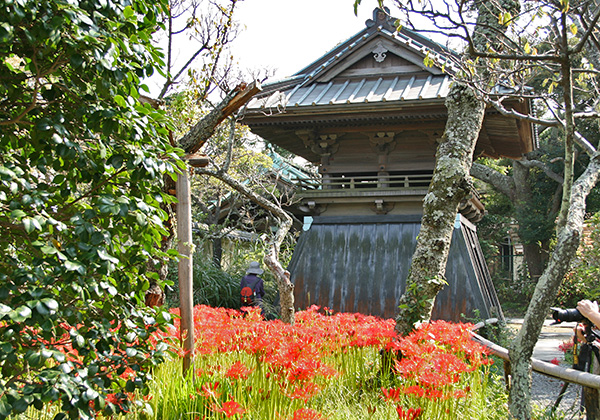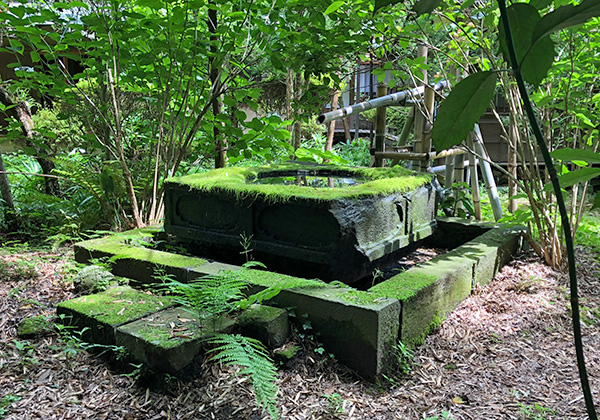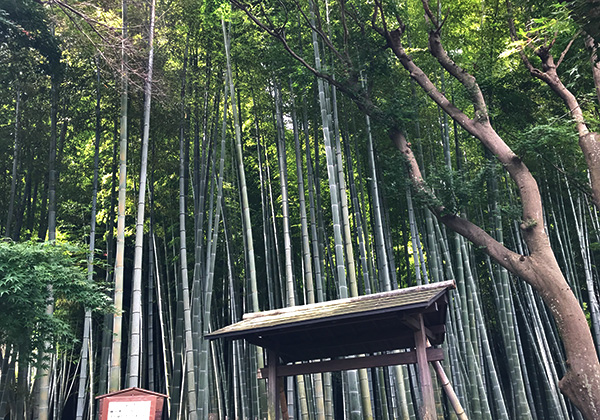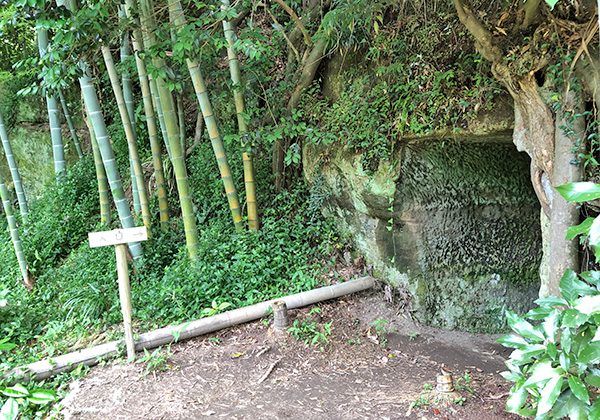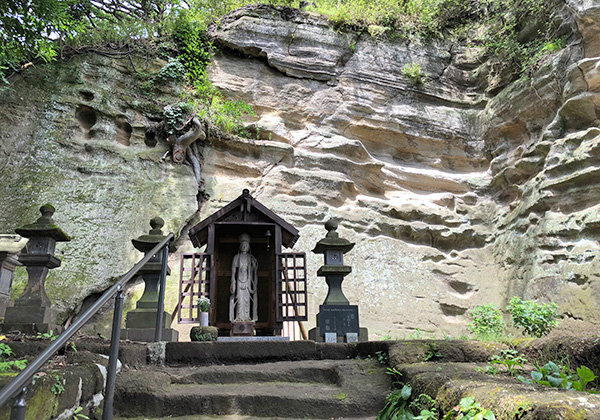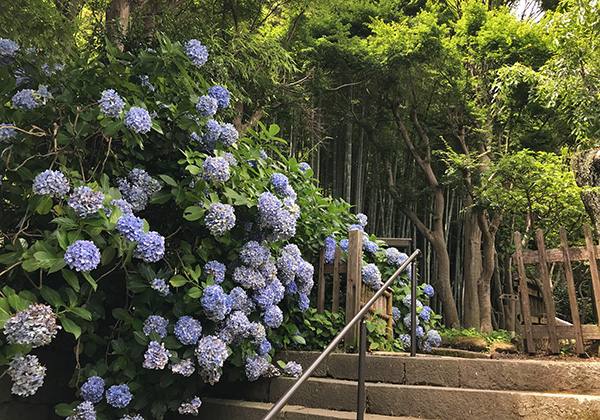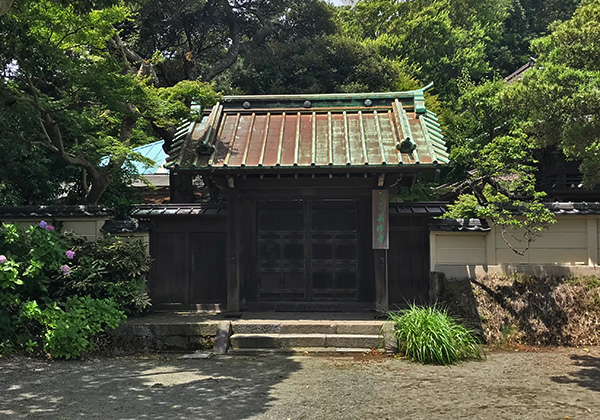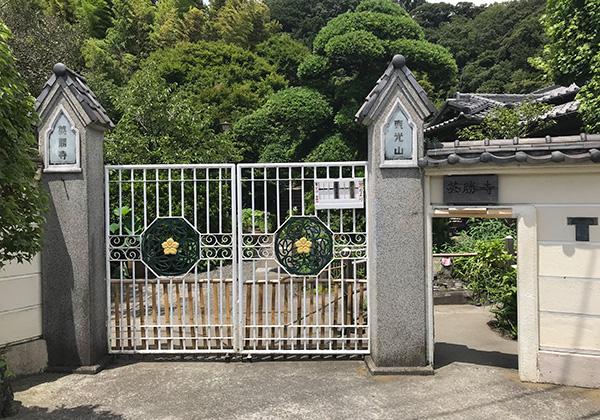Eishoji
| Official Name | Tokozan Eishoji {Pronounced toh-koh-zan a-shoh-gee} |
|---|---|
| Religious sect | Jodo sect, Buddhism |
| Founded | in 1636 by Court Lady Okatsu {o-KAH-tsu}, a.k.a. Seishun Choyo Founding nun : Sei-in Gyokuho {say-in gyok-hoh} |
| Main object of worship | Statue of Amida Nyorai or Amitabha in Sanskrit |
| Address | 16-3, Ogigayatsu 1-chome, Kamakura, Kanagawa 248-0011 (show route from current location ) |
| Location | 700 meters north of Kamakura Station |
| Time needed to get there | 10 minutes |
| Admission | JPY300 |
| Open | 9:00 - 16:00 Closed on Thursdays |
| Phone number | 0467-22-3534 |
| Restrooms | Not available |
Historical Overview
This is the only convent extant in Kamakura and relatively new built in the early Edo Period (1603-1868). To better understand the Convent, we need to look into the family of the Tokugawa Shogunate, which was established by Ieyasu Tokugawa {e-eh-yah-soo toh-koo-gah-wah} (1542-1616), one of the most prominent heroes in Japanese history. Shortly after Ieyasu unified Japan in 1603, he separated his immediate family members to three domains in a move to form feudal clans across the nation; one in Mito {me-toh} in Ibaraki Prefecture, one in Nagoya and the other in Wakayama Prefecture. Those three branches of Tokugawa families enjoyed the most important and powerful position among many feudal lords, and once in a while inherited the seat of the Shogun in case the head Tokugawa family in Tokyo did not have heirs apparent.
Among the court ladies who served Ieyasu was a woman called Okatsu. (Back then, feudal lords had as many concubines as they wished, and one of the Shoguns gave birth to more than 60 children). Whenever Ieyasu was with Okatsu, he could win all battles, and therefore, she was greatly favored by him. In fact, Katsu means "win" in Japanese, a good omen. (O is a prefixal honorific). Okatsu bore him a boy, but he died young.
When Ieyasu ordered Yorifusa Tokugawa (1603-1661), Ieyasu's eleventh son, to assume the first lord of Mito, Okatsu was told to accompany him as his foster mother since he was only three years old. At the demise of Ieyasu in 1616, however, Okatsu made up her mind to enter nunhood and pray for the repose of her lover's soul. She looked for a site to build a convent. Fortunately, Okatsu's ancestor five generations back was a samurai called Dokan Ota {doh-kan o-tah} (1432-1486), and had lived in Kamakura as a key retainer of the Vice Governor in Kamakura. Getting support from Iemitsu Tokugawa (1604-1651), then the Third Shogun, Okatsu built the Convent exactly at the site where Ota had lived 150 years earlier, nominating Sei-in Gyokuho, Yorifusa's daughter, for the founding nun. At the same time, the Convent was named "Eishoji" following her nun name "Eisho-in". Tokugawa family in Tokyo being closely associated with Zojoji, the mother temple of Jodo sect Buddhism located in Minato ward, Okatsu chose the same tenet. At some point of the Edo Period , the Convent was even larger than Kenchoji thanks to the patronage given by the powerful Shogunate.
Dokan Ota is well known to the Japanese because he built a castle in Tokyo for the Tokugawa Shogunate in 1454, which was the prototype of the current imperial palace resided by the imperial family. In the lobby of the Glass Hall near Tokyo Station is a bronze statue of Ota wearing ancient costumes. Another famous episode on him refers to a Tanka or 31-syllable Japanese verse. He was a distinguished samurai warrior as well a scholar learning at the Five Zen Temples in Kamakura. One day, he went out, but, it began to rain. To borrow a straw raincoat, he stopped by a farmer's house replete with beautiful flowers of Japanese rose or Kerria japonica (a deciduous shrub of the rose family). As a young lady came out, he asked her if he could borrow a straw raincoat. She went inside and a bit later appeared with a strip of paper on which a beautiful tanka was written. She cordially presented it to Ota. What she meant by the 31-syllable verse was that though Japanese roses in her house were in full bloom and her house may have seemed rich, the roses bear no fruits at all. Likewise her family could not afford even a raincoat, and she felt sorry for being unable to help him.
As if to remind visitors of this well-known tale, there are Japanese roses planted in the garden of the Convent.
Thereafter, the Mito clan continued to back up the Convent sending their family members as chief nuns, whereby the Convent was dubbed "the Mito Palace". It had long been closed to the public, but began to accept sightseers in spring 1995.
In today's convent grounds, there are Somon {soh-mon} gate, Butsuden {boo-tsu-den} or the main hall, Karamon {kah-rah-mon} gate, Shido {she-doh} (a hall is dedicated to the ancestors' souls), bell, Kuri {koo-re} (Nuns' living quarters), etc.

Butsuden

At the entrance near the nuns' living quarters, visitors have to pay a fee of 200-yen for admission. Butsuden is standing on the left-hand side. What can be seen from here is the rear side. To go to the facade, visitors have to go around it.
Originally built in 1636, this hall is reminiscent of Zen temples in its eaves and looks somewhat like that of Shariden of Engakuji. Enthroned on the altar are statues of Amida {ah-me-dah} trinity, namely Amida statue in the center flanked by Kan'non Bosatsu (Avalokitesvara in Skt.) on its left and Seishi Bosatsu (Mahasthama-prapta in Skt.) on its right. The trinity statues were donated by the Tokugawa family and said to have been made during the Kamakura Period (1185-1333). However, exactly when and by whom they were carved are unknown.
Another statue enshrined in this hall is that of Tora (tiger) Yakushi (Bhaisajya-guru in Skt.), only one of its kind in Kamakura. A 47-centimeter-tall statue of Yakushi Nyorai sits on a tiger, and the namesake of Tora Yakushi.
This Butsuden is also called Hoju-den {hoh-jew-den}. Hoju means mani in Skt., a peach-shaped Buddhist fitting often seen on top of the roof. Unfortunately, occasional visitors are not allowed go inside the hall. In addition, it is too dark inside and statues are rarely made out.
